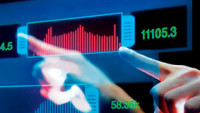 US markets continued their hurricane Irma relief rally yesterday with more record highs for the S&P500 as well as a record close for it as well as the Dow Jones.
US markets continued their hurricane Irma relief rally yesterday with more record highs for the S&P500 as well as a record close for it as well as the Dow Jones.
The positive momentum was also helped by comments from US Treasury Secretary Steve Mnuchin that the US administration was still looking to get some measure of tax reform in place by year end, while there was chatter that Congress was looking at a compromise reduction from the current 35% corporate tax rate to a rate of 23%.
The Apple product launch went pretty much as expected with a new iPhone 8, as well as the iPhone X or iPhone 10, along with a new Apple Watch which doesn’t require an iPhone to make and receive calls. The new price point for the new iPhone X proved to be on point at $999, though consumers won’t see it until November due to parts scarcity. Having rallied into the announcement Apple’s shares closed slightly lower on the day, on disappointment over the delay to the launch.
In Europe sentiment was a little more mixed yesterday with solid gains for the DAX and EuroStoxx 50 as the euro started to slip back, while the FTSE100 underperformed due to a firmer pound.
It’s another important day for inflation as well as wages data today with the final German CPI numbers for August expected to be confirmed at 1.8%.
We’ve seen the pound hit a one year high against the US dollar and push above $1.3300 , after UK inflation pushed back to 2.9% in August yesterday matching the level last seen in May and matching a four year high as a sharp rise in fuel and clothing prices reversed a summer slowdown in prices. A bigger concern was the fact that price pressures showed signs of picking up across the board as core CPI, input prices and retail prices also rose, largely as a result of last year’s rate cut and stimulus plan from the Bank of England.
In a way the Bank of England has been fortunate, as another 0.1% rise in CPI to 3% would have resulted in Mark Carney having to write a letter to explain to the Chancellor of the Exchequer that it was the banks actions a year ago that caused the bank to miss its inflation target, an almost delicious irony.
One side effect of last month’s jump in inflation is that it has forced markets to readjust its expectations of when we might see a probable rate rise, given that some on the MPC are concerned that inflationary pressure could start to become a little stickier than is desirable.
Today’s wages and unemployment data could well shift that dial further particularly if wages show further signs of edging higher in response to a tightening labour market. Over the last couple of months average earnings have managed to recover from lows of 1.7% to recover to 2 1%. This recovery is expected to continue in July with a rise to 2.2%, while the unemployment rate is expected to remain at a 42 year low of 4.4%.
A solid wages number could shift the calculus on the MPC further towards a rate rise with Chief economist Andrew Haldane likely to join the other two hawks Michael Saunders and Ian McCafferty in pushing for a rate rise, given recent comments he made during the summer, when inflation ticked up to the same level it is now. He suggested that “beginning the process of withdrawing some of the incremental stimulus provided last August would be prudent moving into the second part of the year”, though the caveat was that the data supported such a move.
We will also be getting a snapshot of US factory gate prices later in the day and here we are expecting to see a similar uptick in prices for August with a rise from 1.9% to 2.5%, a quite considerable turnaround. Seeing that we’ve seen a significant turnaround in the US dollar in the last couple of days, a strong number here could well prompt further US dollar gains and squeeze US dollar short positions further.
Interest rate rise expectations for both the pound and the US dollar have shifted markedly in the past couple of days with the probability of a December rate rise jumping up from the low 20% level to the mid 30% level in the last week
EURUSD – this week’s break below the 1.1980 area could well signal that we’ve seen a short term peak around the 1.2090 level, with a break below the 1.1910 level opening up the prospect of a move towards 1.1820. For now the larger resistance remains at the 1.2170 level which is the 50% retracement of the 1.3995/1.0340 down move.
GBPUSD – The break through the 1.3225 area has prompted a break through the previous highs at 1.3270 bringing a move towards 1.3320 into focus. This would complete the April breakout of the triangle consolidation. Support now comes in at 1.3220.
EURGBP – the break below the 0.9040 area and the 50 day MA and has found some support at the 0.8980 area, and could see a move towards the 100 day MA at 0.8845. The 0.9220/30 level remains the key resistance on the top side while we also have trend line resistance at the 0.9170 level.
USDJPY – this week’s strong rebound back through the 108.50 level suggests we could well be heading back to the 111.00 area in a classic bear trap which saw last week’s break below 108.20 quickly reversed.














